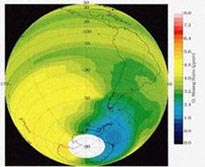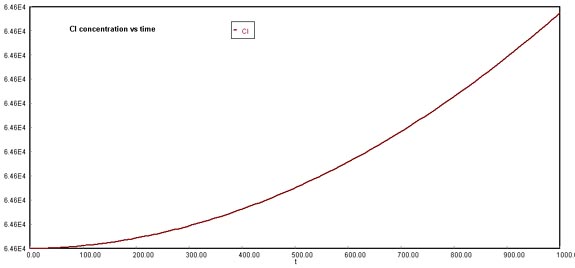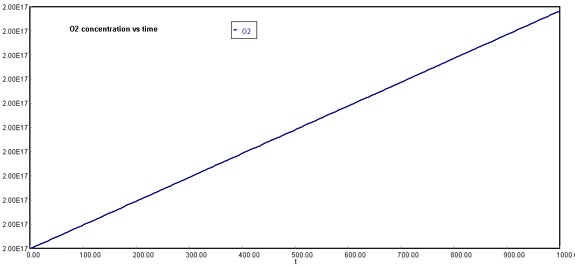Ozone Depletion
Web Module
Anjan K. Chakrabarti
Alejandra De Obeso
Dr. Nihat M. Gürmen
Prof. H. Scott Fogler
![]()
![]()
![]()
1) Use the reaction pathways discussed in the Reactions section in order to create a model of the catalytic ozone depletion caused by chlorine ions in the stratosphere. The typical conditions of the stratosphere 30 km above the Earth's surface are 300ºK and 1,000 Pa. Initial concentration rates and rate coefficients at these conditions are available through the NIST Kinetics Website and Brasseur and Soloman's Aeronomy of the Middle Atmosphere. Apply a PSSH (pseudo-steady-state hypothesis) to the free radical ions, in order to obtain differential equations that can be solved through Polymath. Analyze your numerical and graphical results to gain a better understanding of your proposed model.
Applying chemical reaction engineering principles, we use the reaction pathways to develop mole balances per chemical species, coming up with an algebraic expression of reaction rates in which the substance is consumed and/or produced. If the subtance is consumed, its reaction expression will be negative; if the substance is produced, its reaction expression will be positive.
.JPG)
Applying PSSH (Pseudo-Steady-State Hypothesis)
By applying PSSH to this model, you will be considering that the rate coefficient of O, Cl, and ClO is just too high in comparison to the other reaction rates in the mechanisms, wich means that O, Cl, and ClO react just as rapidly as they are created. This will further signify that your differential equations for these three substances will equal '0', as if they were part of a steady-state mechanism.
The ultimate goal of applying PSSH is to come up with algebraic expressions that do not depend on the concentrations of these free radicals. In this model, you will be solving a system of equations for O, Cl, and ClO, to be further substituted into the rate expressions of O2, O3, (ClO)2, and ClOO.
The mathematical procedure is detailed to a full extent in Chapter 7 of Dr. Fogler's Elements of Chemical Reaction Engineering. Furthermore, the complete step-by-step solution of the PSSH model is available in .PDF format, in the Downloads section. Only the final equations are shown in the image below:
To download the mathematical procedure directly, click here:
equations chlorine.pdf
Entering the above rate laws, specific reaction rates, mole balances, and initial species concentrations into any differential equations solver will model this system as an imaginary batch reactor 30 km above the Earth’s surface.
WARNING
The differential equations for the system above are very stiff. Most differential equation solving programs will have difficulty with them since the time steps for each reaction vary so greatly. For Polymath, the model with these initial concentrations can only be run for a time period of 7x104 seconds or less before it collapses. As a result, the realistic effects of ozone depletion cannot be examined, but the mechanism of chlorine catalyzed destruction of ozone can be understood and observed. However, if you would like to change the initial conditions of the system, you might find out that the time threshold will be reduced or augmented.
Here is a screen shot of the equations entered into Polymath’s Differential Equation Solver.
Download the original Polymath file of this problem, by clicking here:
Model chlorine.pol
This is a display of the report printed by Polymath. Notice the reaction rates, as well as the decrease in ozone concentration, and the final distribution of the free radicals.
Finally, this is a graph produced by Polymath of ozone concentration over the 1000 second period of time. Notice the steady decline caused by the chain reactions set off by chlorine.
Behavior of O3 through timeOn the other hand, it is expected to find an increase in chlorine concentration due to the liberation of free radicals that appear after chlorofluorocarbon breakup. In comparison to the previous image, one can actually understand why the release of chlorine radicals is so alarming, since their concentration increases in a non-linear manner at a faster rate than ozone can renew itself.
Behavior of Cl through timeThe following image shows a steady increase of pure oxygen in the stratosphere, in agreement with the pattern of ozone destruction:
Behavior of O2 through timeNote that this model can be changed, varied, and perturbed for different situations. Also, better models can always be developed from other differential equation solvers.
2) You are a scientist from Mars (Venus, of course, if you are a lady), and you plan to dominate the Earth by eliminating all human beings on the planet. After a careful study of their atmosphere, you have determined that these treacherous humans rely on a layer of ozone in their atmosphere for protection from deadly UV-B and UV-C radiation. As a scientist from Mars or Venus, you hope to accomplish complete extermination of the humans by decreasing the concentration of ozone by a factor of 10. The only method for destroying ozone that your current technology is capable of is increasing the initial concentration of chlorine in the stratosphere using the Chlorineaddemophier. Unfortunately, the humans will notice and rectify the effects of the Chlorineaddemophier within 1000 seconds.
Being a cost efficient Martian (or Venusian) scientist, you want the Chlorineaddemophier to do as little work as possible. The task set before you is to determine the lowest initial concentration of chlorine needed in the stratosphere to decrease the ozone layer by a factor of 10 in 1000 seconds.
There is no numerically direct way of solving this particular problem. The strategy that would be easiest to follow is to actually change the intial concentration of chlorine by an 'x' factor, run the model, and notice how much it affects the final concentration of ozone. If the initial concentration of ozone is 5E12 molecules/cm3, you must aim at getting 5E11 molecules/cm3 in your results page in order to decrease ozone by a factor of 10. After constant trial-and-error, you will conclude that the initial concentration of chlorine needed to finish off these pesky humans lies somewhere between 1.887E8 and 1.888E8 molecules/cm3. For Mars (Venus)!

.jpg)
.jpg)

